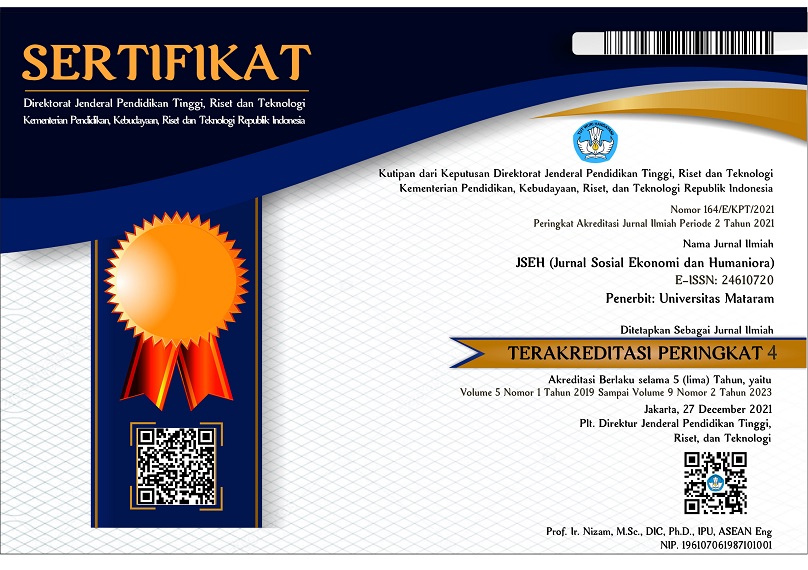Persepsi Petani Melon Terhadap Perubahan Iklim Di Desa Ganti Kecamatan Praya Timur Kabupaten Lombok Tengah
DOI:
https://doi.org/10.29303/jseh.v11i2.752Keywords:
Climate Change, Farmers’ Perceptions, Melon, Rainfall Patterns, Extreme WeatherAbstract
The agricultural sector is the most vulnerable to the impacts of climate change, particularly for horticultural farmers such as melon growers. This study aims to analyze melon farmers’ perceptions of climate change in Ganti Village, East Praya Subdistrict, Central Lombok Regency. A quantitative survey method was applied. The location was selected purposively as Ganti Village is a central melon-producing area. A total of 30 respondents were selected using the snowball sampling technique. Primary data were collected through structured questionnaire-based interviews and analyzed descriptively. The results indicate that farmers have strong perceptions of three key aspects of climate change: changing rainfall patterns, extreme weather events, and their impacts on agriculture. Farmers identified specific indicators of the onset and end of the rainy season as well as heavy rainfall as signs of changing precipitation patterns. Regarding extreme events, they recognized the timing of strong winds, floods, and droughts. Perceived impacts include increased pest and disease incidence, reduced yields and quality, higher crop failure risks, unpredictable water availability, and changes in crop varieties each planting season.
References
Badan Pusat Statistik. (2022). Produksi Buah–Buahan dan Sayuran Tahunan Menurut Jenis Tanaman di Kabupaten Lombok Tengah. Lombok Tengah
Capstick, S., Whitmarsh, L., & Poortinga, W. (2015). International Trends in Public Perceptions of Climate change Over the Past Quarter Century. Wire's: Climate Change, 6, 35-61.
Food and Agriculture Organization of the United Nations. (2013). Good Agricultural Practices for Greenhouse Vegetable Crops : Principles for Mediterranean climate Areas. (R. N.-W. N. L. A. H. Wilfried Baudoin, Ed.). Food And Agriculture Organization Of The United Nations
Grothmann, T., & Patt, A. (2005). Adaptive Capacity and Human Cognition: The Process of Individual Adaptation to climate Change. Global Environmental Change, 15(3), 199-213.
Handoko, R. (2022). Dampak Perubahan Iklim terhadap Produksi Tanaman Hortikultura di Indonesia. Jurnal Agronomi Tropis, 12(1), 45-56.
Intergovernmental Panel on Climate Change (IPCC). (2012). Managing the Risks of Extreme Events and Disasters to Advance Climate Change Adaptation, Cambridge University Press, Cambridge, UK, and New York, NY, USA.
Irianto, G. dan N. Heryani. (2003). Teknologi pemanfaatan iklim untuk menunjang pertanian skala mikro. Proseding Seminar dan Lokakarya Aspek Klimatologi dan Lingkungan serta Pemanfaatannya. Bandung.
Juanda, A., Sudrajat, H., & Wibowo, T. (2020). Peningkatan Populasi Hama akibat Perubahan Iklim pada Tanaman Melon. Jurnal Perlindungan Tanaman, 18(2), 112-123.
Pauw, P. (2013). The Role of Perception in Subsitence Farmer Adaptation in Africa-enriching the Climate Finance Debate. International Journal Climate Change Strategies Management, 5(3), 267-284.
Rakhmat. (2000). Psikologi Komunikasi. Yogyakarta: Kanisius.
Rainforest. (2022). Pendekatan Pestisida & Pengelolaan Hama Terpadu Kami diakses dari ttps://www.rainforest-alliance.org/id/business-id/sertifikasi/pendekatan-pengelolaan-hama-terpadu-pestisida/
Santoso, A., Widodo, R., & Fajar, M. (2019). Dampak Perubahan Iklim terhadap Kualitas Buah Melon. Jurnal Hortikultura, 20(4), 201-213.
Sugiyono. (2012). Metode Penelitian Pendidikan Pendekatan Kuantitatif, Kualitatif dan R&D. Bandung: Alfabeta.
Sumartono, G. H., Tini, E. W., & Saridewi, P. (2017). Kajian Adaptasi Tiga Varietas Melon dan Pemberian Pupuk Organik Cair ke Dataran Rendah terhadap Hasil. Jurnal Ilmu-Ilmu Pertanian, 24(1).
Sugiyono. (2014). Metode Penelitian Kuantitatif, Kualitatif, dan R&D. Bandung: Alfabeta
Setiapermas, M.N. & Zamawi. (2015). Pemanfaatan Jaringan Irigasi Tetes di dalam Budidaya Tanaman Hortikultura. Dalam I. Djatnika, M. J. . Syah, D. Widiastoety, M. P. Yufdy, S. Prabawati, S. Pratikno, & O. Luftiyah (Ed.), Inovasi Hortikultura Pengungkit Peningkatan Pendapatan Rakyat. Jakarta: IAAR Press
Syaiful. (2020). Evaluasi Kesesuaian Lahan Untuk Tanaman Melon (Cucumis Melo L.) di Desa Rasabou Kecamatan Hu'u Kabupaten Dompu. Skripsi Fakultas Pertanian.
Singarimbun. (1982). Metode Penelitian Survai. Jakarta : LP3ES
Suryani, I., Nugroho, D., & Setiawan, P. (2020). Ketidakpastian Ketersediaan Air dan Implikasinya terhadap Pertanian Melon. Jurnal Sumber Daya Air, 25(1), 89-100.
Widhiyanti, N. (2007). Perubahan Iklim dan Dampaknya Bagi Kehidupan. (http://walhibali.org/terbaru%20/Prubahan-iklim-dandampaknya-bagi-kehidupan.html).Diakses pada tanggal 12 Februari 2025.
Wahyuni, D., Rahayu, S., & Budi, T. (2021). Perubahan Suhu dan Dampaknya terhadap Produksi Tanaman Melon. Jurnal Agroklimatologi, 17(2), 134-145
Downloads
Published
How to Cite
Issue
Section
License
Copyright (c) 2025 Arman Suryadi, Hayati Hayati, Taslim Sjah

This work is licensed under a Creative Commons Attribution-NonCommercial 4.0 International License.







